Programmes Living Pictures Revived Known Persons
The better known and lesser known Zagreb people – persons from everyday life and those important for having had a hand in watershed events in Zagreb from the earliest history to the present day that are presented in the project Living Pictures.

In 1094, when the diocese of Zagreb was founded, Bishop Duh presented the crown to the Croatian-Hungarian King Ladislav Arpàd I, while the king presented the bishop with the emblems of the office of bishop. Most deserving the credit for the first written mention of Zagreb in history is the anonymous scribe of a document of Archbishop Felician, 1134, in which the name Zagreb is used for the first time.
.jpg)
In 1242, His Majesty King Bela IV with the charter called the Golden Bull gave numerous privileges to the citizens of the free and royal city on Gradec. In the ceremonies of the events of the court, the king was escorted by Queen Maria and men-at-arms of the King’s Guard.
.jpg)
Margareta the Sorceress, accused of being a witch in 1340, was by a sentence of the city judge, pursuant to the evidence, condemned to be burned at the stake. Journalist Marija Jurić Zagorka wrote her novel Grička vještica / Witch of Grič making use of these historical circumstances. Authoress and journalist, the first professional woman journalist in Croatia as well as fighter for women’s rights, she wrote in Jutarnji list / Morning Newspaper, and in 1925 founded the first women’s periodical, Ženski list za modu, zabavu i kućanstvo / Female Paper for Fashion, Entertainment and Household, which she also edited.
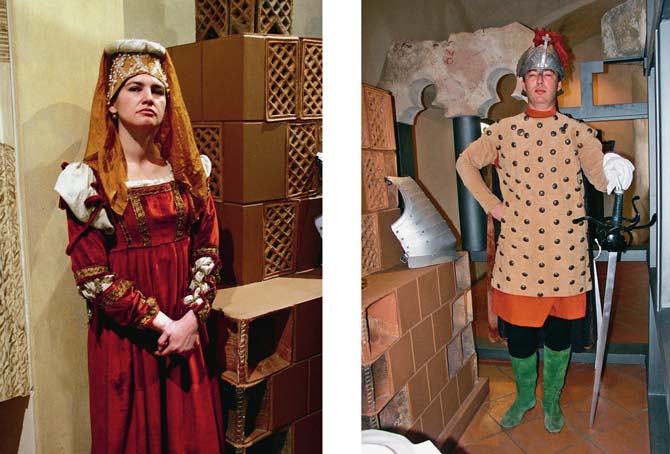
Among the various masters of Medvedgrad Castle, most often mentioned among the ordinary people was Barbara Celjska, daughter of Count Ulrik Celjski, in the living legend of the Black Queen of Medvedgrad.
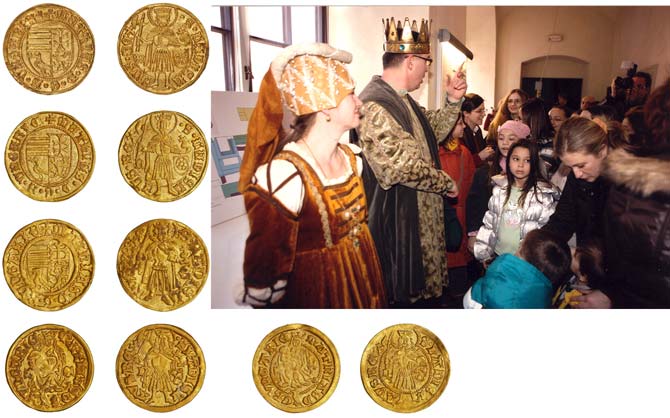
Croatian-Hungarian King Matthew Corvin was elected king of Hungary in 1458. He was called Corvin from the raven, Latin corvus, on his shield. He made successful war against the Turks and Habsburgs, and reformed the state. In 1463 he issued a writ that allowed the Zrinski family to extract silver from Medvednica. He married a second time on September 15, 1476, to the daughter of the King of Naples Ferdinand I – Beatrice. Both of them spent time on Gradec, staying for three months in the winter of 1481, at which time a parliament of the kingdom was held. In 1485, the king had a wall and tower built around the monastery in Remete; five of his gold coins were found during archaeological excavations at Remete.
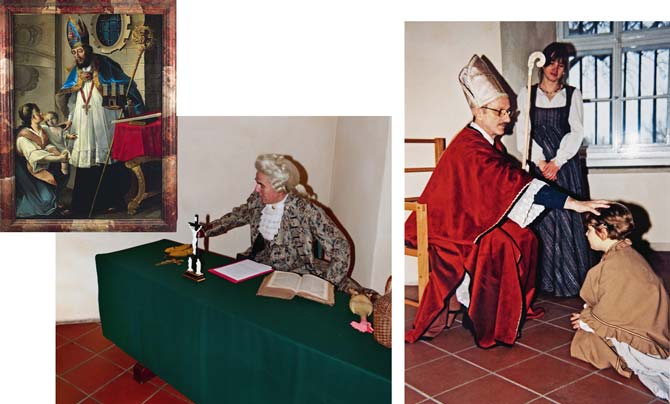
The town judge Adam Ballogh boasted to the commons that it was he that had, in 1749, at his own expense, commissioned a picture of St Blaise, and then donated it to the city to grace the council chamber. In the painting are St Blaise in bishop’s robes, patron saint of Zagreb’s Gradec, represented with a model of the city in his hand, and an ordinary woman and child whom he had cured of ailments of the throat.
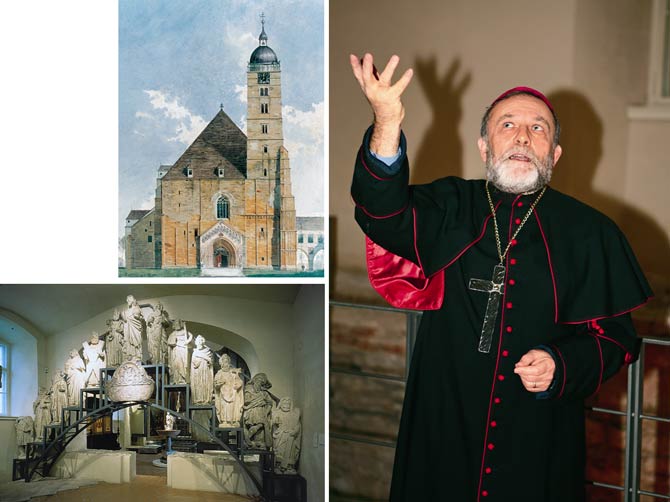
In 1640 Bishop of Zagreb Benedikt Vinković commissioned the building of the monumental main portal of the cathedral and entered into a contract with the mason Kozmo Müller of Krško. He had talks with the religious Juraj Križanić (according to the contents of their extant correspondence).

The painter Ivan Eisenhorth of Ljubljana, painter of altarpieces for the winged altar of St Ladislav in the cathedral, finished his great work at the end of the17th century. The painted scenes link the ancient legend of the life of Ladislav king and saint with historical events in Croatia.

Architect Herman Bollé started the reconstruction of the cathedral after the earthquake of 1880 in which it was seriously damaged, and the reconstruction lasted until 1902. He had himself photographed for a memento in 1897 by the completed tower (104 m high), with good reason to be proud of his work.

Mihajlo Pucak also known as Škrlec was, in the royal town, head of the guild of goldsmiths, swordsmiths, locksmiths and blacksmiths. The guild looked after the altar of the Blessed Virgin Mary in the parish church of St Mark’s, by the side of which the guild flag, made in 1729, was kept.

The married couple Antonija and Gjuro Eisenhuth, master carpenter, lived in Kamenita St. 13, where his workshop was also to be found. He went on with the traditional family trade, but had his children taught music. Successful citizens, they had their portraits painted around 1845.
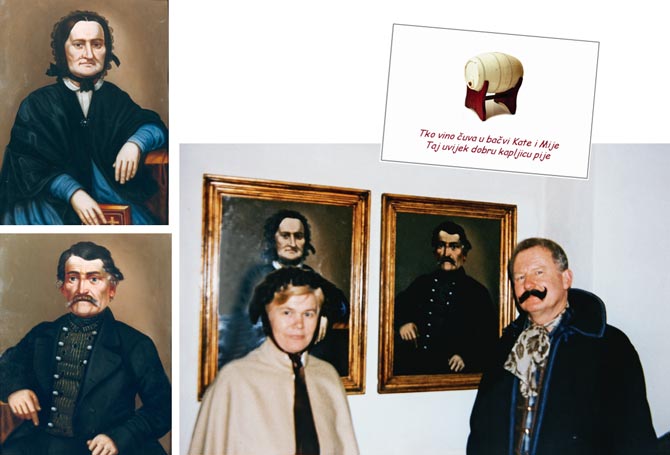
The cooper Mijo Budicki bought a large grange and opened up his coopering workshop in what was then Samostanska, now Varšavska, street. Kata, his wife, looked after the journeymen who after their spell on the road at last returned to Zagreb. An unknown painter limned their portraits on sheet metal around 1850.

Bellfounder Henrik Degen came to Zagreb from Lubeck in 1833. He made a church bell in 1839, and cast over 260 bells in his foundry in Zvonarnička St. 3, in which he worked until his death. This, the oldest Zagreb foundry, had then existed on the same place for more than four hundred years, and the street took its name from the yard (zvono means bell).
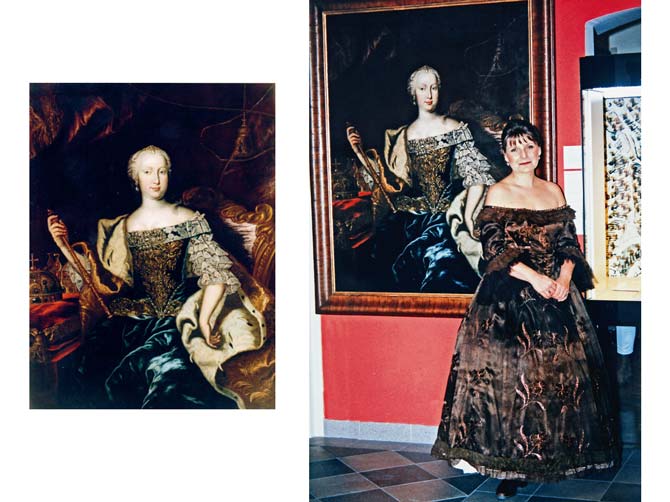
Queen Maria Theresa Habsburg-Lothringen posed for her many portraits by court painter Martin von Meytens. During the reforms of 1755 she shifted the capital of Croatia to Varaždin, where it stayed until the great fire of 1776, after which it was restored to Zagreb.

Baron Franjo Trenk, Austrian colonel, favourite of Maria Theresa, was an outstanding military leader, adventurer, bon vivant, and leader of the pandurs. Controversial to the end, Trenk was killed in 1749.
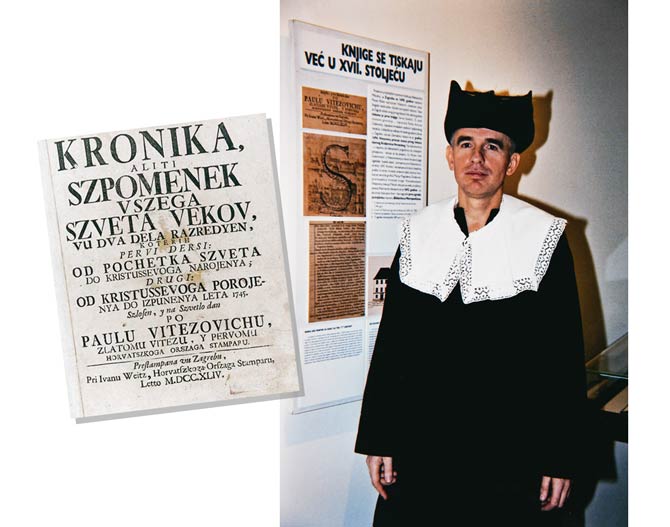
Pavao Ritter Vitezović, writer, historian, politician, worked in Zagreb as publisher, printer and bookseller. The first printer of the famous Kingdom of Croatia ran a printing shop in Zagreb from 1695 to 1706. His shop in the County Building on St Mark’s Square burned down in a conflagration.

Franjica Novosel, the sister of Bishop Maksimilijan Vrhovec, was the wife of Antun, owner of a printing shop that in 1796 issued the first Croatian translation of a book for children, Mlaissi Robinzon (Robinson Crusoe), a moralistic and didactic work. The book was printed in the bishop’s, later in Novosel’s, printing shop in Zagreb, the originator and founder of which was the bishop, Maksimilijan Vrhovec.

Judita Petronila Zrinska became mother superior or abbess of the Order of the Poor Clares in Zagreb. The cloister was built thanks to the city Magistracy, which gave the Clares the land, and the first nuns moved into the cloister on July 15, 1650. They founded a school for girls, in which they gave lessons in German and in music. Her famous parents Petar and Katarina Zrinski gave her a dowry of 12,000 forints, but after the tragic death of her father, the government in Vienna confiscated all the assets of the Zrinskis. Still, thanks to the many years of advocacy from the bishop and the chapter, in 1676 the court in Vienna did pay out the dowry of Petronila, the largest in the history of the Zagreb convent.
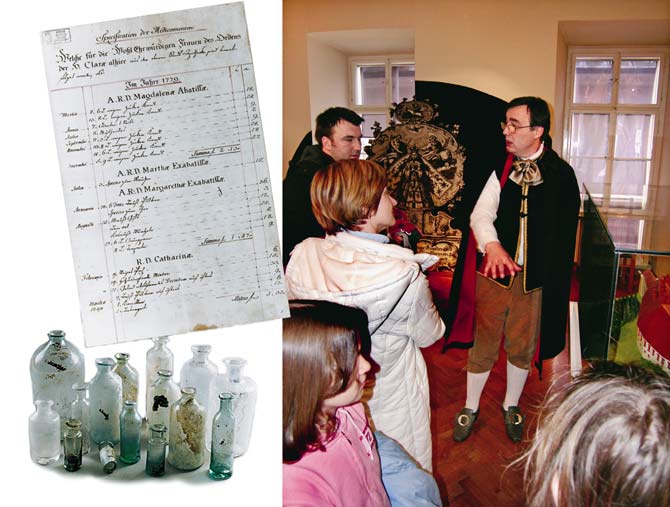
In the 18th century the apothecary Karl Froschl issued medicines to sick nuns and sent an account to the convent for services rendered from 1779 to 1781.
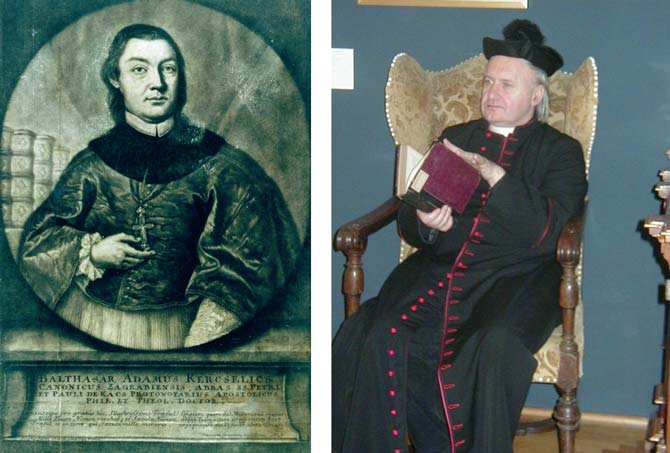
Canon Balthazar Adam Krčelić recorded the events of his time. The most important of his works for Zagreb is the Annuae or History in which he systematically recorded Zagreb events from 1748 to 1767, systematically describing the opulence of Baroque aristocratic life in Zagreb. His work was not published because several truthful and often scandalous details of the lives of individual contemporaries were described.

Prompted by his promotion, in 1743, vice-governor Ivan Rauch had four family portraits made. A portrait of his wife Katarina with son Pavel, and portraits of daughters Cecilija, Barbara and Ana Maria. Ana Maria Rauch could not imagine what kind of family gossip, adventures, piquant and lewd details from the life of her family were to be recorded by Baltazar Adam Krčelić, mentioning, among other things, that Katarina had gone mad and her husband had had to cope with a madwoman, while Barbara had fornicated in her father’s house (on St Mark’s Square no. 2) with Stjepan Josip Žuvić and become a mother before she was a wedded wife. At his death, her father did not mention her, but designated a sum of 500 forints for the peace of her soul.

Count Antun Amade de Varkony was the owner of the palace in which the first theatrical performances started to be given, in 1797. What was before called Blatna [Muddy] Street acquired the name Theatre Street, and the theatre, after the owner of the palace, the Amade Theatre.
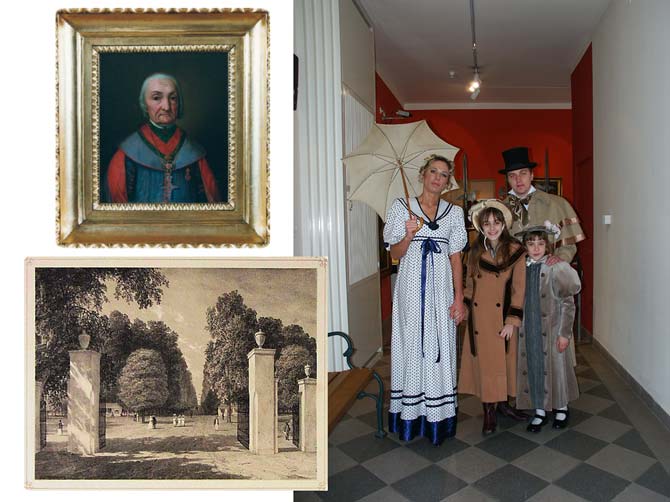
The first to have a park laid out on the diocesan estate was Bishop Maksimilijan Vrhovec, but the landscaping was completed by Bishop Juraj Haulik in 1853. Thanks to Haulik the park was allowed to be used by the public. If they had been able to walk around the park together, Bishop Juraj and Bishop Maksimilijan might well have discussed the proper name for the park – whether it should be Jurjaves or Maksimir.

Thanks to the urging of Matija Pallain, controller of posts and of Bartol Felbinger, the northern promenade of Gradec was laid out, and here, below Popov Toranj (tower) in 1844 Pallain opened a small cafe and confectioner’s, the still popular Palajnovka, looking onto Kipni square. The building of the cafe was made after a design by Felbinger.

Elegant youth at the wedding of Dragutin Barbot, son of a manufactory of stoneware at Nova Ves and the first factory owner for ceramic vessels and stoves Vjekoslav Barbot in 1888 socialised with the many other guests to the sound of musicians from the surrounds of Velika Gorica.

At the time of the Croatian National Revival Ljudevit Gaj, one of the leaders of culture during the Illyrian Movement used the advertiser to announce the opening of his printing shop, and issued an invitation to subscribe to the first Novine Horvatzke / Croatian Newspaper, which started coming out in 1835. He dressed in Illyrian costume and wore a red cap with Illyrian symbols, which he also had embroidered on his travelling bag.

Sidonija Erdödy Rubido, famed for the role of Ljubica in the first Croatian opera, Love and Malice, first performed in 1846, became a figure on a queen card of the cards known as Cards of Zagreb Halls, published by Josip Bäck of Zagreb.
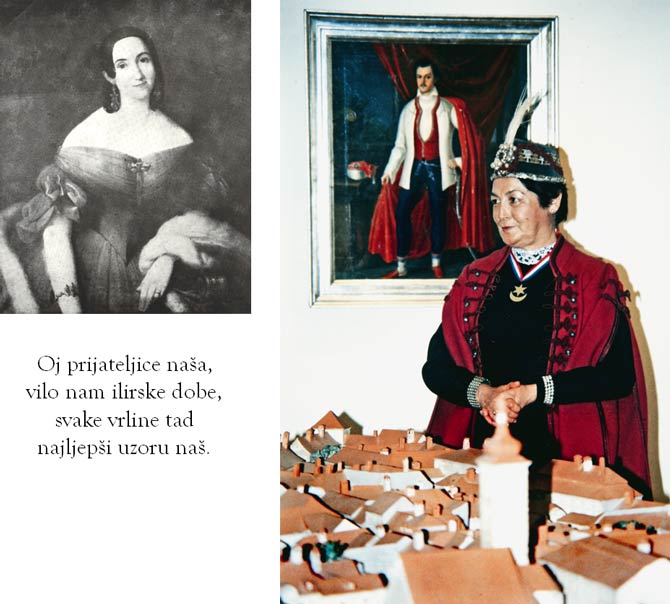
Josipa Vancaš, known as the Illyrian mother, brought together the leaders of Illyrianism in her house in Opatička St.

Marija Jambrišak, taught girl pupils, and was one of the founders of the first Girls’ Boarding School in Croatia in 1900, located in a private school in Upper Town in Opatička street. In 1895 she wrote a book called Behaviour about proper conduct in all circumstances in life, Guide for conduct in the family, in society and public life, saying that: Courtesy, amicability and charm harmonise life and thus deserve to be cultivated.

The installation of Josip Jelačić Bužimski as first Croatian ban was held according to the two-day ceremony of installation on June 4 and 5 1848, and the actual act of installation took place in the open air in front of the Church of St Catherine, whither Jelačić arrived by coach, to the cries of the gladdened multitude of people gathered together.

Sofija Jelačić, the young ban’s lady, became a widow at the age of 25, and wore widow’s weeds, putting on a black crinoline and black jewellery. Only three days after the death of the ban in 1859, the city Magistracy, i.e. the city authority, ordered a portrait of the ban in his tricolour installation uniform from the painter Ivan Zasche for the council chamber of the town hall.

Unlike the pictures that graced many Zagreb homes in the Beidermeier period, that which was ordered by the pharmacist Mittelbach, who came from Vienna and worked in the apothecary’s of Juraj Augustin in Duga St. no. 14, showed the client’s children, playing “the doctor visits a sick child”. Painter Matija Brodnik painted the children playing, carefully watched over by their nanny between 1840 and 1850.

Baroness Cornelia Balbi, like other ladies, having spare time aplenty, spent much of it on needlework. On one of her pieces, which she did on a silk cloth with multicoloured silken threads, with hair, glass beads, wax and metal threads, she showed so much skill that the sampler was like a picture. She embroidered it with her monogram, CB, and the year it was made, 1860.
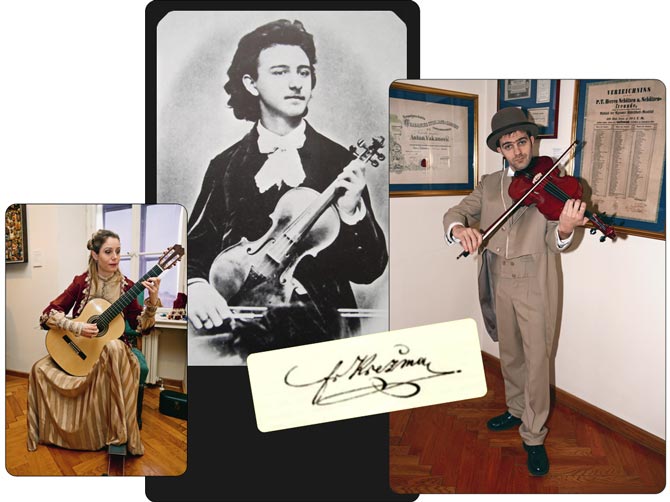
A girl pupil of the Music School at the Music Society, founded in 1827, took part in the programme of the pupils’ performance on August 4, 1844. The music school was founded and opened on February 16, 1829, in the building of the Academy on Katarina Zrinska Square. The music school developed into the Music Academy, at which Franjo Krežma, violin virtuoso, was also schooled.
.jpg)
Baron Ambroz Vranyczany-Dobrinović felt the need for systematic lessons in dancing and etiquette, and at the end of 1859 he called in to Zagreb the ballet master Pietro Coronelli, dance teacher at the Maritime Academy in Rijeka, to be the private dancing teacher of his daughter Clothilde. Coronelli soon after founded the first permanent dance school in Zagreb in the hall of the Shooting Range in Tuškanac. For the Zagreb of the time, with a population of about 17,000, this was a big event. After the death of maestro Coronelli, the lessons were kept up by his daughter Elvira.
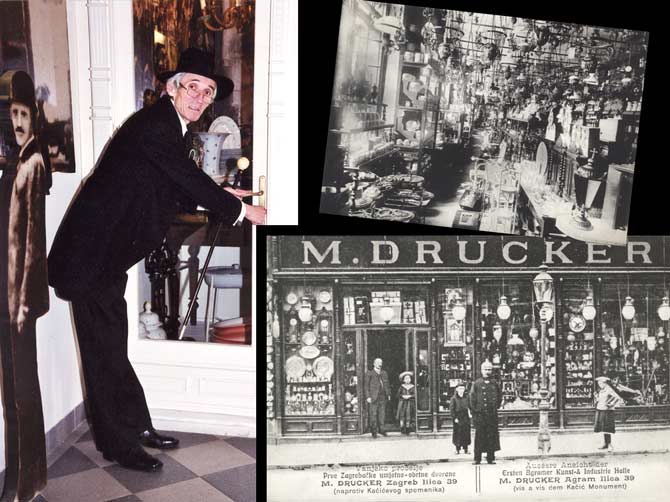
Mavro Drucker was the owner of the first Zagreb Art and Craft Hall, at Ilica 39. In 1898 he opened a shop in which items that it had once been impossible to buy in Zagreb could be acquired. Previously they had been bought abroad, mainly in Vienna. This was an emporium – for sewing machines, bicycles, Chinese silver, real gold and silver ware, jewels, clocks and watches, Wertheim cash boxes, typewriters, cameras, gramophones, photographs, gramophones, appropriate items for tombola and gifts and so on. Drucker’s shop was the first, as early as March 1907, to be lit with the wonderful electric lighting.
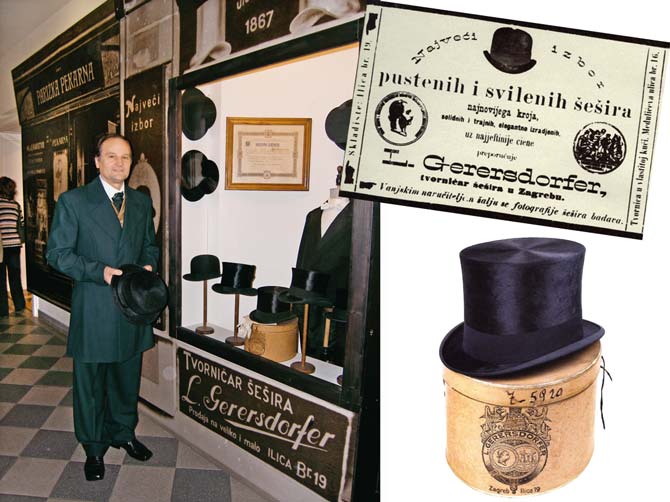
Ljudevit Gerersdorfer opened his hatter’s workshop and shop at Ilica 19 in 1866. He had a hat factory in his own house in Medulićeva no 16. In his many adverts he recommended his big selection of silk and felt hats. After his death in 1898 the shop was inherited by his son, also Ljudevit.
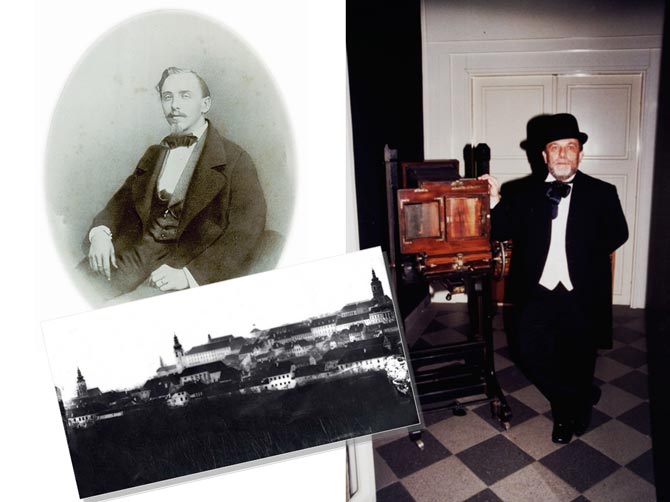
Julije Hühn was in business 32 years, from 1882 to 1914, at Ilica 10, where his Warehouse of Paper at Wholesale and Retail as well as Shop of School, Writing and Paper goods. He had learned lithography and was one of the first photographers in Zagreb; in 1858 he founded his Lithographic Institute, which offered a large range of paper fancy goods, visiting cards, posters, price lists and numerous views of Zagreb done from previously made photographs. Around 1900 the firm made itself well known as the biggest publisher and seller of Zagreb postcards.
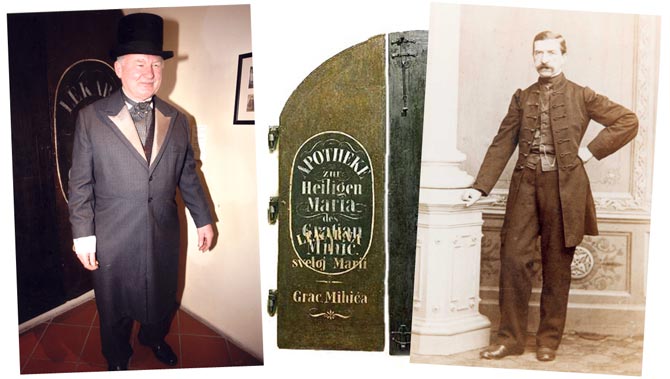
Gracijan Mihić, owner of the apothecary At St Mary’s at no. 7, Dolac, borough of Famous Kaptol of Zagreb, took over the premises in 1852, and then it gained the name of the new owner on the wooden door of the portal. He ordered the decorative paper labels for the wrappings of drugs from the lithographer Julije Hühn.

Milan Lenuci, town planner, architectural adviser to the city of Zagreb, was in the city authority from 1874. He was one of the most important city engineers. He produced the town plans of Zagreb in the second half of the 19th century and became particularly well known for his plan for a sequence of linked lower town squares that became known as the Lenuci Horseshoe.

Adolf pl. Mošinski was mayor of Zagreb from 1892 to 1904. In the ten years of his office he installed a system of sewage in the town, from 1892 to 1895, put a culvert over the Medveščak brook in 1895-1898, and extended the water supply network. In 1892 the Main Railway Station was built, the National Theatre and the School Forum in 1895, and the Art Pavilion in 1898.
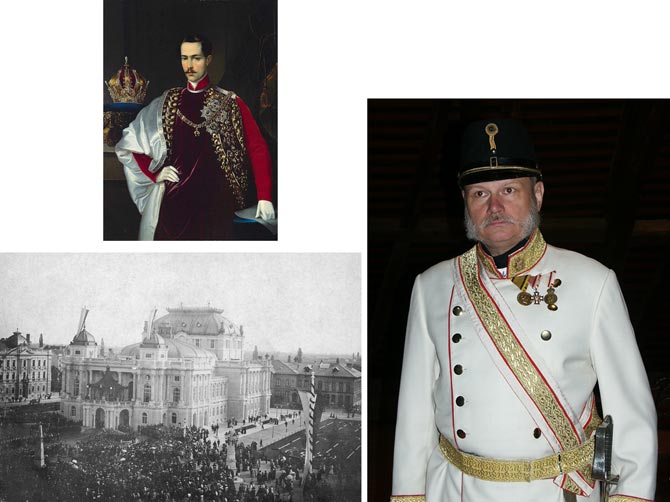
During the royal visit of Emperor Franz Joseph I and Empress Elizabeth to Zagreb on October 14, 15 and 16, 1895, festive architectural decoration was put up according to plans of Zagreb architects. It was installed on the squares and streets meant for the procession of the royal suite along the city from its arrival at the station. Mayor Adolf Mošinski was host to King and Emperor Franz Joseph I, and during his visit to Zagreb the Emperor opened the new National Theatre and the School Forum. The first performance in the new theatre building was the opera Nikola Šubić Zrinski by Ivan pl. Zajc, the composer.

His Imperial Majesty Franz Joseph I went hunting in his old
age, although the empire was weltering in the blood of the
Great War. To encourage men to go off to fight for King and
Country more eagerly, they were reminded of him by his
pictures in the displays of the stores in the Zagreb streets.

Baroness Olga Vranyczany, famed for her entertainments in her home, the luxuriously appointed revivalist palace on Academy Square, built in 1879, today the Modern Gallery. This spirit of luxury was seen in parties in the performances of favourite amateur performances that followed the fashionable Tableaux Vivants, which, according to his painters, were arranged by well known Croatian painter Nikola Mašić. Thus at a big masked ball in 1887, there were special invitations to the home of Baron Vranyczany for a party featuring Living Pictures.

Milka Trnina, the Croatian nightingale, famed opera singer, was feted throughout Europe and America. She appeared with great success in Zagreb and equally so on the stages of the world’s opera houses – London, Munich, New York and Boston, until her farewell to the stage in 1906. She appeared at the Royal Opera House in London 56 times.

Miss Fisher, dressmaker for theatrical costumes in the costume department of London’s Covent Garden, made unique costumes that remained Milka’s property. As for the world’s operatic diva, she knew everything; and yet of Zagreb, from which Milka came, she knew nothing.

Stjepan pl. Miletić was the first manager of the Croatian National Theatre (National Provincial Theatre) in the new building of the Lower Town (1894-1898).

Painter Marijana Mücke, daughter of Josip Franjo Mücke, also a painter, made a portrait of opera singer Marija Prikril Crnadak in 1887, in the role of Marguerite de Valois in Meyerbeer’s Les Huguenots. The picture was made in thanks to the singer, who posed for the picture of the Virgin placed in the Church of St Mary in Zagreb.
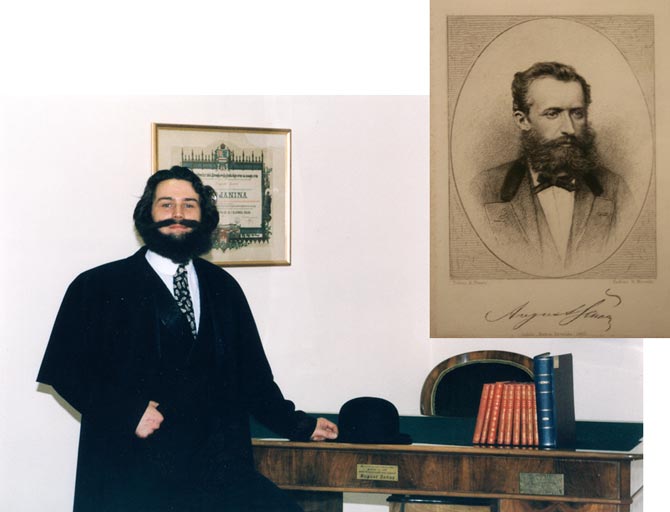
August Šenoa, the most popular Croatian writer of the 19th century, and Zagreb city senator, was elected honorary citizen of Zagreb on September 30, 1881 because of his services to the capital defending and promoting its interests.

Countess Turković visited the Jubilee Exhibition in 1891, at which the Turković brothers, estate owners of Kutjevo, showed the products of their forestry industry in their own pavilion. In memory, the family of the exhibitors had their photos taken for a souvenir.

In Jurišićeva street there was once an inn that people would visit for beer and snacks during the 1870s and 1880s. The owner of the At the Three Ravens Julije Wellisch and a pretty young waitress from this well-known restaurant would offer the guests Zagreb Schnapps (Komovica) and Croatian Balm. During carnival every Saturday there would be carnival events in the rooms decorated in historical styles.
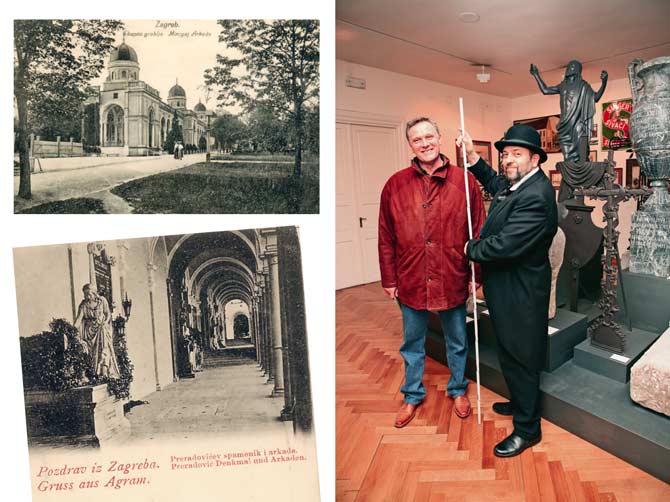
Mr Majcen was the manager of the main municipal cemetery at Mirogoj, which was opened officially on November 6, 1876. The first deceased to be buried there was Friedrich Singer, on November 7, a teacher of gym and fencing, for whom the city put on a grand funeral.

The first director of the City Museum in Zagreb, Emilij pl. Laszowski, was a member of the Brothers of the Croatian Dragon association, which founded the museum. He managed everything to do with the museum by himself from its founding in 1907 to 1926. In this period he wrote out by hand the card index catalogue for 1185 objects that had been acquired and inventoried.
Josefina Laszowska, his third wife, whom he married in 1908, came from Vienna, where they had met and dallied (although his second wife Asta was still alive) while Emilij was studying the organisation and work of the Vienna City Museum.
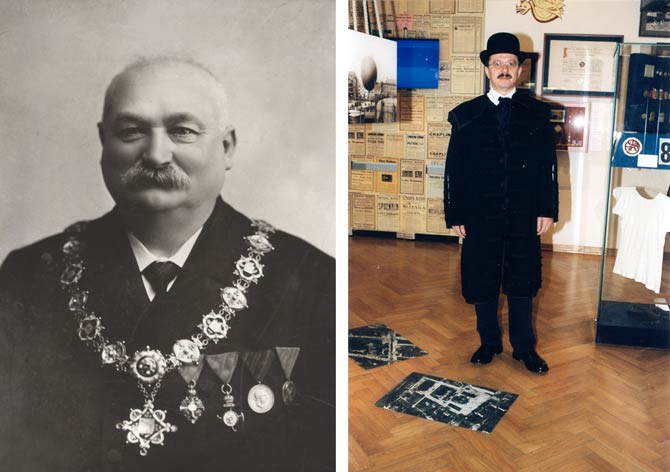
The city museum, archive and library were opened in 1907 by mayor Milan Amruš, although he was better known for having opened the first public convenience in the city.

Ida Feller, wife of druggist Eugen Feller, who made a fortune selling his panacea Elsa Fluid, could proudly say that her husband had had the first five-storey building in the city put up in 1905.
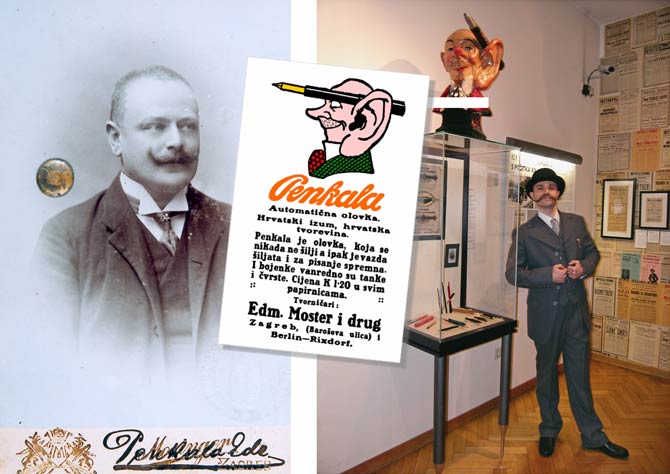
Slavoljub Penkala achieved world fame with the invention of the first automatic propelling pencil in 1906. He patented his invention under the family name of Penkala. The popular penkala became a need for everyman that has lasted until this day. On the 100th anniversary of the invention, 2006, the inventor came to life in the museum.

Because of the large number of customers, the barber Većeslav Librić in his barber shop in Radićeva 20, in a shop in a building just across the way from Kamenita vrata / Stone Gate, would often leave the notice "Back At Once" on the door, but his regular customers would always wait patiently, and always get a turn. He opened his shop in 1941, and worked for his many customers for almost 40 years, until he retired in 1979.
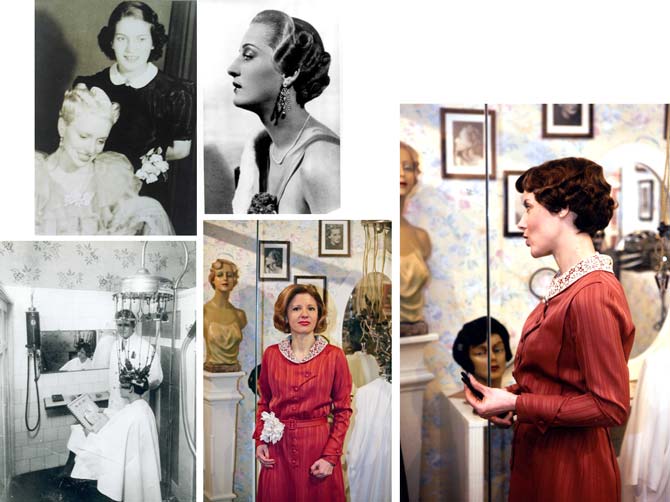
Branka Kincl, top hairdresser and her husband Rudolf opened their own salon in Praška St. no. 8 in 1935. In 1937 at the world hairdressing competition she won first place among 500 entrants, gaining the Grand Prix de Paris. Just as in the Ema Hairdressing Salon the ladies would be beautified with water permanents, although the process took hours.

Kamila Radovan, one of the first women drivers, kept the steering wheel of pressed Bakelite for the Model A Ford, Torpedo body of 1927. In the open car she had to wear special glasses, leather cap, coat and gloves. At the competitions of the Autoklub, part of the Zagreb Fair, her hottest competition was Mihela Carnelutti, who took 1st prize with her Horch cabriolet at the Concours d’Elegance for cars in 1932.

Antun Štrban, famous Cezet motorcyclist, started his career at Kustošija in 1920. He took part in competitions held at the track in Črnomerec, then in the newly built track of Miramare. On these tracks, he was practically invincible. In 1930 he achieved the success of his life in Pardubice winning the Czech Golden Helmet in front of 40,000 spectators. His success resounded around Europe.

The architect Mladen Kauzlarić designed the Villa Spitzer in Novakova 15, for Vilim Spitzer, Zagreb wholesaler in coal, coke and wood, in 1932.
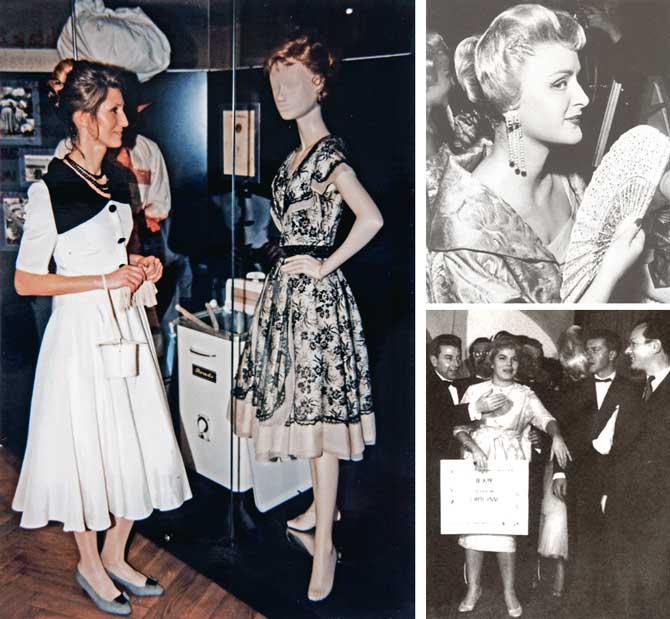
One of the best known Zagreb hairdressers, Mrs Vesna Kincl Murtić, in 1957 won first prize of Europe at the international hairdressing competition and a year later the first prize at the world championship in Paris for an evening hair-do. On the occasion, she bought herself an elegant gown in the French capital.

Ivan Gerersdorfer, clockmaker and lover of mechanical musical automata assembled during his lifetime a large collection. The sounds of music could be heard from his dwelling in a palace at Demetrova 7, where he lived, and everyday looked after the sensitive mechanisms of his automata that were sometimes his only society.
Željka Kolveshi
photo Miljenko Gregl
design Maja Šojat-Bikić, MSc

